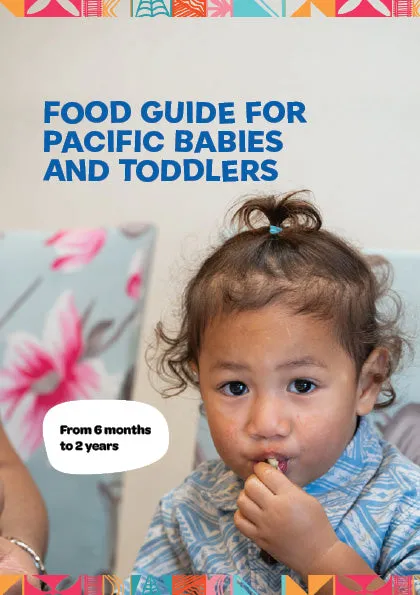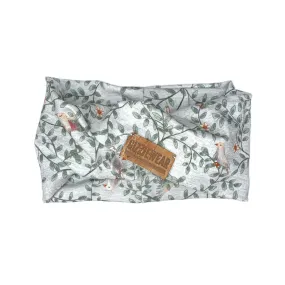From 6 months to 2 years
WHY IS EATING WELL IMPORTANT?
Your baby needs goodness from a variety of foods for growth and for building the foundations of good health for the rest of their lives.
When I fed my baby, I felt the connection back to my ancestors by feeding them traditional Pacific foods. I knew I would be passing on their strength to our future generations.
WHEN IS MY BABY READY FOR FOOD?
Around 6 months old, breast milk or infant formula alone do not provide everything your baby needs to grow and develop. This is the time to offer baby solid foods, alongside breastfeeding (or formula).
Your baby may also be showing these signs:
- They can hold their head up and sit with a little support
- They open their mouth as food approaches
- They can keep food in their mouth and swallow it
Do not give your baby food before they are around six months old. Their mouths and tummies are not ready to digest it yet.
HUNGER & FULLNESS SIGNS
Your baby knows how much their body needs for growth and energy for learning and play – so trust them, and follow their hunger and fullness signs.
Signs my baby is hungry:
- Open their mouth to welcome the food
- Leaning toward the breast or food or pointing at foods
- Becoming agitated or excited
- Crying (try to soothe before you start to feed)
Signs my baby is full:
- Slowing or stopping sucking , releasing the nipple or teat
- Pushing food or plate away, or turning their head away
- Sealing lips together or spitting out food
- Becoming distracted with what’s going on around them
WHAT FOODS SHOULD I GIVE MY BABY?
Every food has a different job in our body, that’s why it’s so important to eat a variety of foods, especially for babies, as they are growing so quickly.
At mealtimes, offer baby a food from each group:
Health and protective
foods like fresh, frozen, canned vegetables or fruit provide vitamins and minerals for strong immune systems and eating vegetables helps get baby used to the taste.
Building foods
are meat, fish and dairy foods. They have protein, iron and calcium for growing strong bodies and bones.
Energy foods
like bread, rice or Pacific starchy vegetables provide carbohydrates for energy to grow, learn and play.
STARTING SOLIDS
To keep your baby safe, begin by feeding them smooth, puréed food with a spoon. Start with one meal each day, after they have had a breast milk or formula feed.
You can introduce any food that the family is eating, as long as it has no added sugar and salt
There’s no need to try just one food at a time, unless it’s a main allergy causing food (see
Baby’s iron stores from mum are getting low, so offer high iron foods like beef, fish and well-cooked taro leaves
You can start offering water as a drink so baby can start practising drinking from an open cup
Don’t have a blender? Just push the food through a sieve with the back of a spoon
Baby’s food doesn’t need to be bland! Add flavour like curry powder, spices and lemon
FOOD IDEAS:
Puréed chicken, spinach and taro
Puréed pork , pumpkin and carrot
FROM AROUND 6-8 MONTHS
After 1-2 weeks of puréed foods, you can start offering soft mashed/lumpy foods to help develop their biting and chewing skills.
Continue to offer breast milk or formula before food.
You can increase to two meals per day, depending on your baby’s hunger.
You can continue to offer a mix of puréed foods with mashed and soft foods.
You can also offer large pieces of cooked or ripe soft foods (without skins, pips or seeds) they can pick up and feed themselves.
To test if a food is soft, it should be easily squashed between your thumb and finger.
FOOD IDEAS:
Mashed chicken, taro leaves and green banana
Mashed fish and peas with soft pumpkin
FROM AROUND 8-10 MONTHS
You can now offer food first, then breast milk or formula as a top up after meals.
Try loading the spoon with food and letting baby practise spoon feeding themselves.
Following your baby’s hunger cues, you can start to offer 3 meals per day.
You can offer smaller, slightly firmer finger foods to help baby practise picking up food with their thumb and finger.
Minced and finely chopped foods can also be introduced.
FROM AROUND 10-12 MONTHS
Between 10-12 months, continue to offer a range of different tastes and textures from what the family is eating, just cut it into small pieces.
Continue to make sure you are taking out baby’s portion before adding any salt (for example soy sauce) or sugar.
At this age, your baby is developing their independence, so provide them with toddler
cutlery so they can start to practise to self-feed.
FOOD IDEAS:
Seafood and spinach soup with taro
FROM AROUND 12 MONTHS & BEYOND
By 12 months, most children will be eating the same food as the family, as long as it is low in sugar and salt.
You can now offer whole fat cow’s milk (dark blue label) as a drink. If baby is having formula, there is no need to change to ‘toddler milk’.
For health benefits, if you are breastfeeding, continue to offer this until your baby is at least two years or older.
It is easier for toddlers to sense that they are full when they drink from an open cup rather than a bottle, so use an open cup (without a spout).
Limit cow’s milk to no more than 350mls per day, so their tummies don’t fill up on milk. Offer it after or in-between meals.
In addition to 3 meals, you can start to offer 2-3 snacks per day, depending on your child’s appetite. Think of snacks as mini meals, with at least 2 food groups, to keep them full.
FOOD SAFETY FOR BABIES AND TODDLERS
Babies are at higher risk of getting food poisoning because their tummies and immune system are still developing. Follow the same rules that you did during pregnancy – clean, cook, chill.
Clean
Wash hands, fruits and vegetables and kitchen equipment before preparing foods.
Cook
Cook meat and eggs until cooked through (then let them cool before offering to baby). Do not reheat leftovers more than once.
Chill
Keep food cold in the fridge and eat leftovers within two days.
There are some higher risk foods for babies & toddlers:
To reduce the chance of food poisoning, do not feed babies (under 1 year):
Honey
To reduce the chance of food poisoning, do not feed babies or toddlers:
Raw fish or shellfish
Some foods need to be cooked before feeding them to your baby or toddler:
Eggs – cook eggs until they are firm
Frozen berries – bring them to the boil, then cool
WHAT FOODS SHOULD I AVOID GIVING MY BABY?
Try to wait until your baby turns two before giving sugary or salty foods. This is to protect their kidneys and their growing teeth. It also helps babies to enjoy the taste of natural food.
Do not add sugar to baby’s food or milk, or offer any sugary foods like ice-cream, lollies and chocolate.
Do not add salt to baby’s food (like soy sauce or stock powders), or offer any salty foods like hot chips and potato chips.
Do not give sweet drinks like juice, fizzy drink or cordial.
Is pre-made food OK for my baby?
Some store-bought baby foods can be high in sugar and/or salt. You can choose food with less sugar and salt by looking at the label.
To make sure your baby is given lots of flavours and textures, save baby food pouches for every now and then. It is best to spoon feed them, to help with baby’s development and experience of the food.
ALLERGY PREVENTION
A food allergy is when the body has a reaction to a food. You can reduce the risk by introducing allergy causing foods before the age of one.
Introduce one new allergy causing food at a time and watch out for any signs of an allergic reaction. If there’s no reaction, offer it regularly (twice weekly) to keep up tolerance to it.
Don’t avoid introducing allergy causing foods to babies with eczema or who have a sibling with allergies, as this may increase the risk of developing an allergy.
Ideas to introduce common allergy foods from 6 months:
- Stir smooth peanut butter into meals
- Cooked fish
- Well-cooked egg
- Wheat: Pasta, noodles, bread & toast
- Cow’s milk used in cooking. Cheese or yoghurt.
- Soy: from soy and linseed bread, or tofu
- Add almond or cashew paste or ground walnuts to food
- Mix sesame seeds or sesame oil into baby’s meal
What does a reaction look like and what do I do?
If your baby has swelling of the lips, face, around the eyes or has hives, discuss it with your doctor.
If your baby is showing signs of difficult or noisy breathing, wheezing, swelling of their tongue or is pale and floppy, call an ambulance.
GAGGING AND CHOKING
Babies and toddlers are at risk of choking because their airway is very small and they are still learning to bite, chew and swallow.
To keep your child safe, make sure they sit down while they eat and are always supervised when eating or drinking.
What is gagging?
Gagging on foods is normal. It is a reflex all babies are born with that protects them from choking.
Signs of gagging include:
- Crying or watery eyes
- Retching, spluttering or coughing – their face may turn red
- They may vomit
Try not to panic. Let your baby work the food out on its own, because if we step in, it can increase the risk that the gag will turn into a choke.
REMEMBER: Loud and Red, let them go ahead
What is choking?
Choking is not normal and can be life threatening. It can occur when food gets stuck in the airways so your child will struggle to breathe or be unable to make a noise.
Signs of choking include:
- They will be silent, and become still
- Their face may turn blue This requires help straight away.
REMEMBER: Silent and Blue, they need help from you
This one-minute video shows you what to do if your baby is choking:
A HELPFUL GUIDE TO REDUCE THE RISK OF CHOKING
Small round foods
Remove pips and seeds then quarter or finely chop, for example
- Quartered grapes or berries
- Cooked and squashed peas
- Chopped cherry tomatoes
- Seedless water melon
Compressible foods
Chop to the size of child’s fingernail, for example
- Pieces of cooked meat
- Sausages
Stringy foods
Peel skin and slice the foods thinly across the grain of fibre, for example
- Celery and pineapple
- Silverbeet and bok choy
Small hard foods
Grate, thinly slice or cook them, for example
- Thinly sliced apple
- Grated carrot
- Cooked celery
Meat with skin or bones
Remove skin or finely chop, remove bones, for example
- Chicken nibbles
- Fish
Raw leaves
Finely chop, for example
- Lettuce and spinach
Fruit with skin
Grate, thinly slice or cook & cut into strips, for example
- Plums, apples and pears
- Tomatoes
Thick pastes
Spread a thin, even layer, for example
- Peanut/nut butter
Don’t give these foods as they are more likely to cause choking:
- Whole nuts
- Popcorn
- Large seeds
- Dried fruit
- Chippies
- Candy
- Hard rice crackers
- Marshmallow
LEARNING TO EAT
Babies and toddlers need to learn to like certain flavours, like the bitterness of vegetables – so try to include them in family mealtimes.
Making mealtimes screen-free will help your child listen to their body and get the full experience of eating.
Encourage your child to feed themselves, for example, put food on a spoon for them to pick up.
To help your child learn how to cope with different emotions without using food, try not to offer food as comfort, entertainment or a reward.
TIPS FOR FUSSY EATERS
- Keep a meal routine
- This helps your baby feel hungry at mealtimes.
- One family meal
- If they refuse to eat, don’t make them a different meal. You could say, “that’s OK, you don’t have to eat it, but that’s all we have tonight”.
- Serve new food with familiar food
- When giving a new or disliked food, offer it with a familiar food.
- This will help to take the pressure off. Keep offering the same food many
times.
- Eat with your baby
- Eating as a family can help encourage your baby to try new foods.
- Savoury foods
- Offer savoury and bitter tastes regularly as this will help with accepting new flavours.
- Get them involved
- Getting your child involved with food can help.
- Read stories, take them shopping and let them watch you cook.
- Let them explore by helping too.
BREASTFEEDING
Your baby needs only breast milk until around 6 months of age. Breast milk has everything baby needs to grow and develop.
It provides the perfect nutrition for your baby and is convenient. It boosts your baby’s immunity and changes with their needs.
Your baby still needs breast milk (or formula) from 6 – 12 months when they start to eat food. It is beneficial for you and baby to continue to breastfeed when they start to eat food, for up to two years or longer.
See for more information and support.
For information on feeding your baby infant formula, see
SUPPORT IS AVAILABLE FOR YOU
- The Breastfeeding NZ YouTube channel
Has some great videos on breastfeeding, visit:
- Search for "Mama Aroha" and "BreastfedNZ" in the Google Play or iPhone App Store for apps with lots of useful information on breastfeeding
- My Baby’s Village
A group of community organisations calling on Pacific peoples to rally
around parents of newborns. They provide a list of Pacific Well Child
providers – visit: - Smart Start
An online tool that helps parents access the right services for their baby such as support for parenting, breastfeeding, anxiety and depression, budgeting and financial help – visit: - Plunketline
Feeding tips from birth to two years – visit: - Healthy Kids
Fun and free play ideas, low cost family recipes and tips on sleeping – visit: - Healthy Babies Healthy Futures
A free nutrition course for those living in the Auckland and Waitematā region – visit:
Created by The Cause Collective in consultation with the Pacific community.
Nutrition content written by: Registered dietitians Amanda Buhaets, Gabrielle Orr and Soana Muimuiheata.
Original Design by: FI’KA Creative












